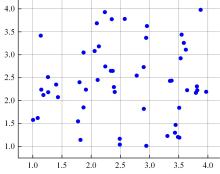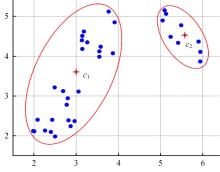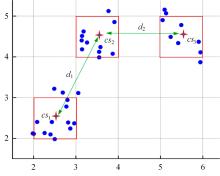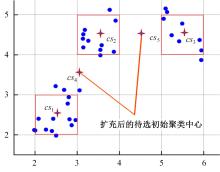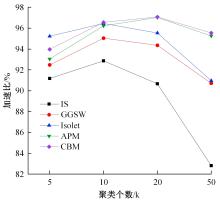Journal of Jilin University(Engineering and Technology Edition) ›› 2024, Vol. 54 ›› Issue (5): 1393-1400.doi: 10.13229/j.cnki.jdxbgxb.20221338
An efficient global K-means clustering algorithm based on weighted space partitioning
Fu-heng QU1( ),Yue-tao PAN1,Yong YANG1,2,Ya-ting HU3,Jian-fei SONG1,Cheng-yu WEI3
),Yue-tao PAN1,Yong YANG1,2,Ya-ting HU3,Jian-fei SONG1,Cheng-yu WEI3
- 1.College of Computer Science and Technology,Changchun University of Science and Technology,Changchun 130022,China
2.Jilin Technology College of Electronic Information,Jilin 132021 China
3.College of Information Technology,Jilin Agricultural University,Changchun 130118,China
CLC Number:
- TP391
| 1 | Rahman M A, Islam M Z. A hybrid clustering technique combining a novel genetic algorithm with K-means[J]. Knowledge-Based Systems, 2014, 71: 345-365. |
| 2 | Harjanti T W, Setiyani H, Trianto J, et al. Classification of mint leaf types based on the image using euclidean distance and K-means clustering with shape and texture feature extraction[J]. Tech-E, 2022, 5(2): 115-124. |
| 3 | 刘仲民, 李战明, 李博皓,等. 基于稀疏矩阵的谱聚类图像分割算法[J]. 吉林大学学报: 工学版, 2017,47(4): 1308-1313. |
| Liu Zhong-min, Li Zhan-ming, Li Bo-hao, et al. Spectral clustering image segmentation based on sparse matrix[J]. Journal of Jilin University (Engineering and Technology Edition), 2017, 47(4): 1308-1313. | |
| 4 | Lim Z Y, Ong L Y, Leow M C. A review on clustering techniques: creating better user experience for online roadshow[J]. Future Internet, 2021, 13(9): 233. |
| 5 | 张萌谡, 刘春天, 李希今, 等. 基于K-means聚类算法的绩效考核模糊综合评价系统设计[J]. 吉林大学学报: 工学版, 2021, 51(5): 1851-1856. |
| Zhang Meng-su, Liu Chun-tian, Li Xi-jin, et al. Design of fuzzy comprehensive evaluation system for performance appraisal based on K-means clustering algorithm[J]. Journal of Jilin University (Engineering and Technology Edition), 2021, 51(5): 1851-1856. | |
| 6 | Fränti P, Sieranoja S. How much can K-means be impr-oved by using better initialization and repeats?[J]. Pattern Recognition, 2019, 93: 95-112. |
| 7 | 杨勇, 陈强, 曲福恒, 等. 基于模拟划分的SP-K-means-+算法[J]. 吉林大学学报: 工学版, 2021, 51(5): 1808-1816. |
| Yang Yong, Chen Qiang, Qu Fu-heng, et al. SP-K-means-+ algorithm based on simulated partition[J]. Journal of Jilin University (Engineering and Technology Edition), 2021, 51(5): 1808-1816. | |
| 8 | Geng X, Mu Y, Mao S, et al. An improved K-means algorithm based on fuzzy metrics[J]. IEEE Access, 2020, 8: 217416-217424. |
| 9 | 邵伦, 周新志, 赵成萍, 等. 基于多维网格空间的改进 K-means 聚类算法[J]. 计算机应用,2018, 38(10): 2850-2855. |
| Shao Lun, Zhou Xin-zhi, Zhao Cheng-ping, et al. Improved K-means clustering algorithm based on multidimensional grid space[J]. Computer Application, 2018,38(10): 2850-2855. | |
| 10 | Manochandar S, Punniyamoorthy M, Jeyachitra R K. Development of new seed with modified validity measures for K-means clustering[J]. Computers & Industrial Engineering, 2020, 141: 106290. |
| 11 | Zhang S, Liu Z, Chen X, et al. Parallel implementation of improved K-means based on a cloud platform[J]. Information Technology and Control, 2019, 48(4): 673-681. |
| 12 | Arthur D, Vassilvitskii S. K-means++ the advantages of careful seeding[C]∥Proceedings of the Eighteenth Annual ACM-SIAM Symposium on Discrete algorithms, New Orleans, USA, 2007: 1027-1035. |
| 13 | Lattanzi S, Sohler C. A better K-means++ algorithm via local search[C]∥Proceedings of the 36th International Conference on Machine Learning,Long Beach,USA,2019: 3662-3671. |
| 14 | Choo D, Grunau C, Portmann J, et al. K-means++: few more steps yield constant approximation[C]∥Proceedings of the 37th International Conference on Machine Learning, Vienna, Austria, 2020: 1909-1917. |
| 15 | Ismkhan H. Ik-means-+: an iterative clustering algorithm based on an enhanced version of the K-means[J]. Pattern Recognition, 2018, 79: 402-413. |
| 16 | Chowdhury K, Chaudhuri D, Pal A K. An entropy-based initialization method of K-means clustering on the optimal number of clusters[J]. Neural Computing and Applications, 2021, 33: 6965-6982. |
| 17 | Nie F, Xue J, Wu D, et al. Coordinate descent meth-od for k-means[J]. IEEE Transactions on Pattern Analysis and Machine Intelligence, 2021,44(5): 2371-2385. |
| 18 | Likas A, Vlassis N, Verbeek J J. The global k-means clustering algorithm[J]. Pattern Recognition, 2003,36(2): 451-461. |
| [1] | Gui-zhen CHEN,Hui-ting CHENG,Cai-hua ZHU,Yu-ran LI,Yan LI. A risk evaluation method for urban intersections considering drivers' physiological information [J]. Journal of Jilin University(Engineering and Technology Edition), 2024, 54(5): 1277-1284. |
| [2] | Shuai-shuai SUN,Chun-xiao FENG,Liang ZHANG. Path planning for multimodal quadruped robots based on discrete sampling [J]. Journal of Jilin University(Engineering and Technology Edition), 2024, 54(4): 1120-1128. |
| [3] | Zhi-gang JIN,Ren-jun SU,Xiao-fang ZHAO. Psychological assessment method based on heterogeneous graph network [J]. Journal of Jilin University(Engineering and Technology Edition), 2024, 54(4): 1078-1085. |
| [4] | Jing-peng GAO,Guo-xuan WANG,Lu GAO. LSTM⁃MADDPG multi⁃agent cooperative decision algorithm based on asynchronous collaborative update [J]. Journal of Jilin University(Engineering and Technology Edition), 2024, 54(3): 797-806. |
| [5] | Bo-song FAN,Chun-fu SHAO. Urban rail transit emergency risk level identification method [J]. Journal of Jilin University(Engineering and Technology Edition), 2024, 54(2): 427-435. |
| [6] | Liu LIU,Kun DING,Shan-shan LIU,Ming LIU. Event detection method as machine reading comprehension [J]. Journal of Jilin University(Engineering and Technology Edition), 2024, 54(2): 533-539. |
| [7] | Hao YUE,Qi-yue ZHANG,Zi-yu YANG,Meng-jie REN,Xu ZHANG. Iterative weighted algorithms of static congestion traffic assignment considering spatial queuing [J]. Journal of Jilin University(Engineering and Technology Edition), 2024, 54(1): 136-145. |
| [8] | Zhi-dan CAI,Ming FANG,Zhe LI,Jia-lu XU. Blind remote sensing image deblurring algorithm based on Gaussian curvature and reweighted graph total variation [J]. Journal of Jilin University(Engineering and Technology Edition), 2023, 53(9): 2649-2658. |
| [9] | Shi-jun SONG,Min FAN. Design of big data anomaly detection model based on random forest algorithm [J]. Journal of Jilin University(Engineering and Technology Edition), 2023, 53(9): 2659-2665. |
| [10] | Guang HUO,Da-wei LIN,Yuan-ning LIU,Xiao-dong ZHU,Meng YUAN,Di GAI. Lightweight iris segmentation model based on multiscale feature and attention mechanism [J]. Journal of Jilin University(Engineering and Technology Edition), 2023, 53(9): 2591-2600. |
| [11] | Ying HE,Zhuo-ran WANG,Xu ZHOU,Yan-heng LIU. Point of interest recommendation algorithm integrating social geographical information based on weighted matrix factorization [J]. Journal of Jilin University(Engineering and Technology Edition), 2023, 53(9): 2632-2639. |
| [12] | Jian LI,Qi XIONG,Ya-ting HU,Kong-yu LIU. Chinese named entity recognition method based on Transformer and hidden Markov model [J]. Journal of Jilin University(Engineering and Technology Edition), 2023, 53(5): 1427-1434. |
| [13] | Nan ZHANG,Jian-hua SHI,Ji YI,Ping WANG. Real⁃time tracking method of underground moving target based on weighted centroid positioning [J]. Journal of Jilin University(Engineering and Technology Edition), 2023, 53(5): 1458-1464. |
| [14] | Ben-huai LI,Yan-wen LIU,Lu WANG,Xue-qian CHEN,Wen-jie ZUO. Crashworthiness optimization for frontal⁃end structure of rail vehicle constrained with absorbed energy and crushed displacements [J]. Journal of Jilin University(Engineering and Technology Edition), 2023, 53(4): 982-988. |
| [15] | Yue-kun MA,Yi-feng HAO. Fast recognition method of short text named entities considering feature sparsity [J]. Journal of Jilin University(Engineering and Technology Edition), 2023, 53(12): 3529-3535. |
|
||
